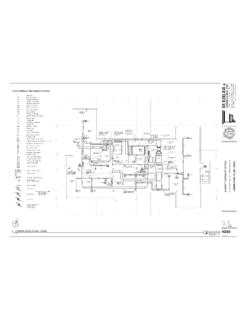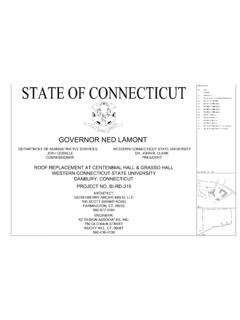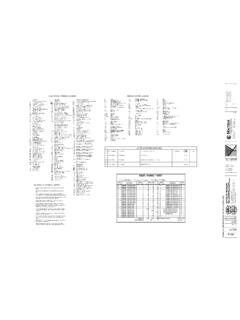Transcription of Petroleum Engineering Handbook
1 Petroleum Engineering Handbook Petroleum Engineering Handbook Larry W. Lake, Editor-in-Chief I General Engineering John R. Fanchi, Editor II Drilling Engineering Robert F. Mitchell, Editor III Facilities and Construction Engineering Kenneth E. Arnold, Editor IV Production Operations Engineering Joe Dunn Clegg, Editor V Reservoir Engineering and Petrophysics Edward D. Holstein, Editor VI Emerging and Peripheral Technologies Warner Jr., Editor VII Indexes and Standards Petroleum Engineering Handbook Larry W. Lake, Editor-in-Chief U. of Texas at Austin Volume VII. Indexes and Standards Society of Petroleum Engineers Copyright 2007 Society of Petroleum Engineers All rights reserved. No portion of this book may be reproduced in any form or by any means, including elec- tronic storage and retrieval systems, except by explicit, prior written permission of the publisher except for brief passages excerpted for review and critical purposes.
2 Printed in the United States of America. The paper used in this book meets the minimum requirements of ANSI/NSIO (R1997).. ISBN 978-1-55563-124-6 (print). ISBN 978-1-55563-125-3 (CD). ISBN 978-1-55563-134-5 (print and CD). ISBN 978-1-55563-126-0 (Complete 7-Vol. Set, print). ISBN 978-1-55563-127-7 (Complete 7-Vol. Set, CD). ISBN 978-1-55563-135-2 (Complete 7-Vol. Set, print and CD). 07 08 09 10 11 12 13 14 / 9 8 7 6 5 4 3 2 1. Society of Petroleum Engineers 222 Palisades Creek Drive Richardson, TX 75080-2040 USA. iv Contents Master Author Index .. 1. Master Subject Index .. 11. SPE symbols Standard .. 103. Overview of the SPE symbols Standard .. 103. Basic symbols in Alphabetical Order .. 107. Economics symbols in Alphabetical Order .. 114. symbols in Alphabetical Order .. 116. Subscript symbols in Alphabetical Order.
3 133. SI Metric Conversion Factors .. 141. Alphabetical List of Units .. 142. Conversion Factors for the Vara .. 150. Memory Jogger Metric Units .. 151. Tables of Recommended SI Units .. 153. Some Additional Application Standards .. 169. SPE symbols Standard Overview of the SPE symbols Standard Principles of symbols Selection Since the original reservoir symbols Standard was established in 1956, the principles used in the selection of additional symbols have been as follows. 1. (A) Use single letters only for the main letter symbols . This is the universal practice of the Ameri- can Natl. Standards Inst. (ANSI), the Intl. Organization for Standardization (ISO), and the Intl. Union of Pure and Applied Physics (IUPAP) in more then 20 formal standards adopted by them for letter symbols used in mathematical equations.
4 (B) Make available single and multiple subscripts to the main letter symbols to the extent neces- sary for clarity. Multiple letters, such as abbreviations , are prohibited for use as the main symbol (kernel) for a quantity. A few exceptions are some traditional mathematical symbols , such as log, ln, and lim. Thus, quantities that are sometimes represented by abbreviations in textual material, tables, or graphs are required in the SPE symbols Standard to have single-letter kernels. Examples are gas/oil ratio (GOR), bottomhole pressure (BHP), spontaneous potential (SP), and static SP. (SSP), which have the following SPE standard symbols : R, pbh, ESP, and ESSP, respectively. 2. Adopt the letter symbols of original or prior author usage, where not in conflict with Principles 3. and 4. 3. Adopt letter symbols consistent or parallel with the existing SPE symbols Standard, minimizing conflicts with that Standard.
5 4. Where pertinent, adopt the symbols already standardized by such authorities as ANSI, ISO, or IUPAP (see Principle 1); minimize conflicts with these standards. 5. Limit the list principally to basic quantities, avoiding symbols and subscripts for combinations, reciprocals, special conditions, etc. 6. Use initial letters of materials, phase, processes, etc., for symbols and subscripts; they are sugges- tive and easily remembered. 7. Choose symbols that can be readily handwritten, typed, and printed. Principles of Letter Symbol Standardization Requirements for Published Quantity. 1. symbols should be standard where possible. In the use of published symbols , authors of technical works (including textbooks) are urged to adopt the symbols in this and other current standards and to conform to the principles stated here.
6 An author should provide a Nomenclature list in which all symbols are listed and defined. For work in a specialized or developing field, an author may need symbols in addition to those already contained in standards. In such a case, the author should be careful to select simple, suggestive symbols that avoid conflict in the given field and in other closely related special fields. Except in this situation, the author should not introduce new symbols or depart from currently accepted notation. 2. symbols should be clear in reference. One should not assign different meanings to a given symbol in such a manner as to make its interpretation in a given context ambiguous. Conflicts must be avoided. A listed alternative symbol or a modifying subscript is often available and should be adopted. Any symbol not familiar to the reading public should have its meaning defined.
7 The units should be indicated whenever necessary. 3. symbols should be easily identified. Because of the many numerals, letters, and signs that are simi- lar in appearance, a writer should be careful in calling for separate symbols that in published form might be confused by the reader. For example, many letters in the Greek alphabet (lower case and 104 SPE symbols Standard capital) are practically indistinguishable from English letters, and the zero is easily mistaken for the capital O. 4. symbols should be economical in publication. One should try to keep the cost of publishing sym- bols at a minimum: no one work should use a great variety of types and special characters; hand- writing of inserted symbols , in copy largely typewritten and to be reproduced in facsimile, should not be excessive; and often a complicated expression appears as a component part of a given base.
8 Instead, one may introduce, locally, a single nonconflicting letter to stand for such a complicated component. An explanatory definition should then appear in the immediate context. Secondary symbols . Subscripts and superscripts are widely used for a variety of conventional purposes. For example, a subscript may indicate the place of a term in a sequence or matrix; a designated state, point, part, time, or system of units; the constancy of one independent physical quantity among others on which a given quantity depends for its value; or a variable with respect to which the given quantity is a derivative. Likewise, for example, a superscript may indicate the exponent for a power, a distinguishing label, a unit, or a tensor index. The intended sense must be clear in each case. Several subscripts or superscripts, some- times separated by commas, may be attached to a single letter.
9 A symbol with a superscript such as prime ( ) or second ( ) or a tensor index should be enclosed in parentheses, braces, or brackets before an exponent is attached. So far as logical clarity permits, one should avoid attaching subscripts and superscripts to sub- scripts and superscripts. abbreviations , themselves standardized, may appear among subscripts. A conven- tional sign or abbreviation indicating the adopted unit may be attached to a letter symbol or corresponding numeral. Reference marks, such as numbers in distinctive type, may be attached to words and abbrevia- tions, but not to letter symbols . Multiple Subscripts Position Order. The wide variety and complexity of subject matter covered in the Petroleum literature make it impossible to avoid use of multiple subscripts with many symbols .
10 To make such usage less confusing, the following guides were used for the order of appearance of the individual letters in multiple subscripts in the symbols list. Use of the same rules is recommended when it becomes necessary to establish a multiple-subscript notation that has not been included in this list. 1. When the subscript r for relative is used, it should appear first in subscript order. Examples: kro and krg. 2. When the subscript i for injection, injected, or irreducible is used, it should appear first in subscript order (but after r for relative ). Examples: Big, formation volume factor of injected gas, and cig, compressibility of injected gas. 3. Except for Cases 1 and 2 above (and symbols kh and Lv), phase, composition, and system sub- scripts should generally appear first in subscript order.





